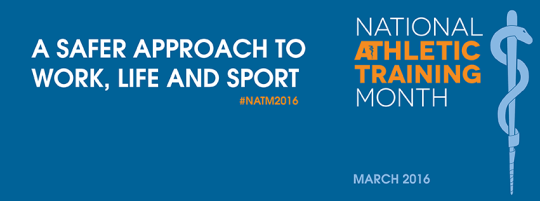Written by Dr. David Geier, American Orthopaedic Society for Sports Medicine

March is National Athletic Training Month. If you coach or work at a high school, or know someone who plays high school sports, you should inquire about the presence of an athletic trainer during sports practices and games. If the school does not currently have access to an athletic trainer, parents, coaches, and the athletic director should work together to try to arrange for athletic trainer coverage.
Why are athletic trainers essential components of high school athletics? Here are just a few of the key functions athletic trainers perform for student athletes:
- Develop emergency action plans
- Monitor field, environment, and weather conditions
- Coordinate injury prevention programs
- Prepare athletes for practices and games
- Communicate with physicians about injuries
- Treat and rehabilitate injured players
- Help determine return-to-play programs for injured athletes
Sadly, only about one-third of high schools in the United States have full-time athletic trainers. Perhaps somewhat more encouraging is the fact that about 70 percent of high schools have at least some form of athletic trainer coverage for games or practices.
Athletic directors often cite shrinking budgets, which limit their ability to hire these healthcare professionals. Schools in rural areas often struggle to attract athletic trainers due to lack of resources.
Simply having a coach with CPR training or one who took a concussion course is not enough to protect young athletes. Likewise, volunteers and EMS crews at games can be helpful, but they don’t replace some of the key duties of an athletic trainer.
See below for five reasons high schools should hire a full-time athletic trainer:
1. Athletic trainers get athletes ready for the season
They help coordinate the pre-participation physical exams. They make sure each athlete has been medically cleared to participate in sports. They can also help arrange follow-up with specialists if abnormal findings are found on an athlete’s exam.
2. Athletic trainers assist athletes as they return to play
Not only can they help an athlete with exercises and other parts of the rehabilitation process, but they can communicate with orthopedic surgeons and doctors to ensure an athlete progresses through an appropriate return-to-play program safely.
3. Athletic trainers prepare athletes for hot weather
They work with coaches to design summer practice schedules to get young athletes ready for hot and humid conditions. They monitor the conditions and advocate for canceling games and practices in extreme temperatures and humidity. They also monitor athletes for signs and symptoms of heat illness and, if symptoms are identified, start body cooling and other treatments to prevent heat stroke.
4. Athletic trainers help with concussion evaluation and management
They can administer baseline concussion tests to athletes before the season. They watch for concussed athletes during games and practices and perform concussion assessments to determine if they can return to play. They can coordinate evaluation by a physician for treatment and return to sports after a concussion as well.
5. Athletic trainers are invaluable in the event of sports emergencies
They coordinate and implement emergency action plans. They ensure any necessary medical equipment is available, including automated external defibrillators (AEDs), spine boards, cervical collars, and much more.
There are many more reasons that schools and sports teams should have athletic trainers present for games and practices. They provide so many important functions to keep kids safe. This March, take steps to make sure you have an athletic trainer present at your or your children’s sporting events.
Spread the word! Share this post with your social media networks using this sample tweet: @AOSSM_SportsMed celebrates National Athletic Training Month on the BAYW blog #NATM2016 #injuryprevention odphp.tumblr.com